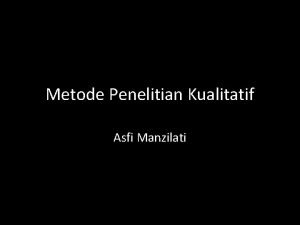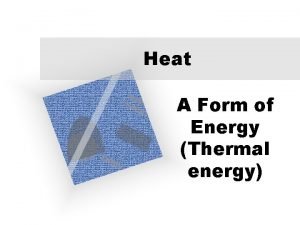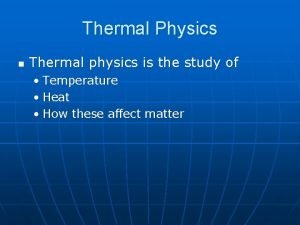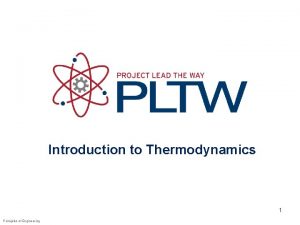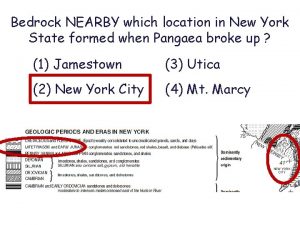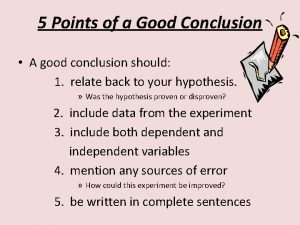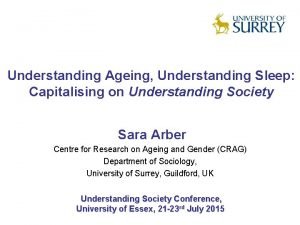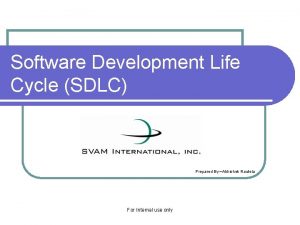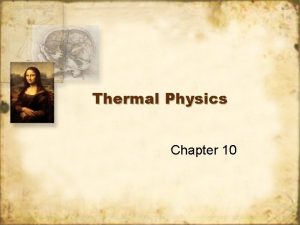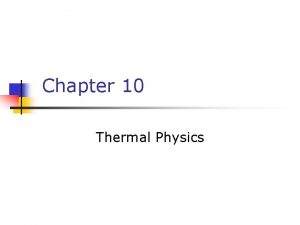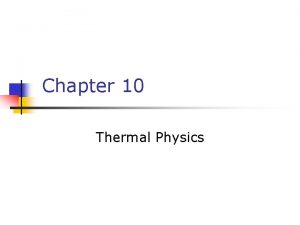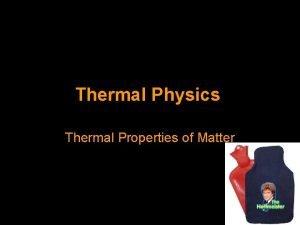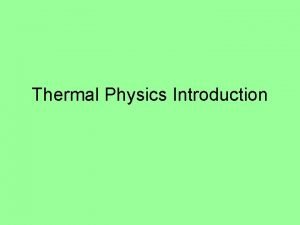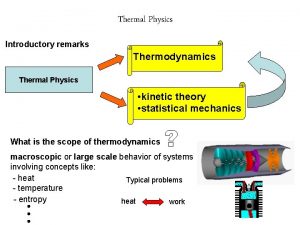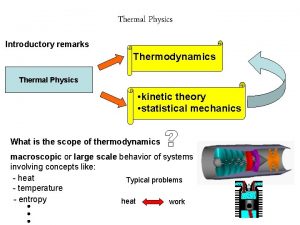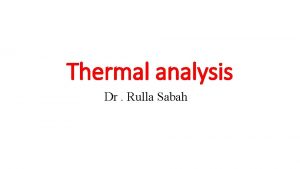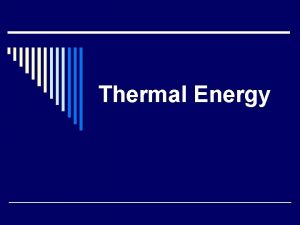Thermal Physics 425625 Acknowledgement I acknowledge the excellent




















































- Slides: 52

Thermal Physics: 425/625 • Acknowledgement: I acknowledge the excellent efforts by Rutgers Physics Professors Misha Gershenson and Weida Wu in preparing powerpoint course material for this textbook. The powerpoint presentations in this course are rooted in their work, with permission from Dr Wu, with modifications by me.

Physics 425/625 Thermal Physics Fall 2011 Prerequisites: Physics 182, 301. Professor: Pat Arnott Office: Leifson Physics RM 213 e-mail: patarnott@gmail. com phone: 775 -784 -6834 office hour: Wed 1: 00 -3: 00 PM and by appointment Class: Tuesday and Thursday 11: 00 am to 12: 15 pm

Physics 425/625 Thermal Physics Fall 2011 Textbook: An Introduction to Thermal Physics, D. V. Schroeder, Addison-Wesley-Longman, 2000 Web Site Access: http: //www. patarnott. com/phys 625 Homework assignments, announcements and notes will be posted here. The link must be visited regularly.

Thermal Physics = Thermodynamics + Statistical Mechanics - conceptually, the most important, enjoyable subject of the undergraduate physics program. Thermodynamics provides a framework of relating the macroscopic properties of a system to one another. It is concerned only with macroscopic quantities and ignores the microscopic variables that characterize individual molecules (both strength and weakness). Statistical Mechanics is the bridge between the microscopic and macroscopic worlds: it links the laws of thermodynamics to the statistical behavior of molecules.

Macroscopic Description is Qualitatively Different! Why do we need to consider macroscopic bodies as a special class of physical objects? For a single particle: all equations of classical mechanics, electromagnetism, and quantum mechanics are time-reversal invariant (Newton’s second law, F = dp/dt, looks the same if the time t is replaced by –t and the momentum p by –p). For macroscopic objects: the processes are often irreversible (a time-reversed version of such a process never seems to occur). Examples: (a) living things grow old and die, but never get younger, (b) if we drop a basketball onto a floor, it will bounce several times and eventually come to rest - the arrow of time does exist. “More is different”, Phil Anderson, Science, 177, 393 (1972)

Ancients struggled with heat: What is it? “It is astonishing to realize that many modern conceptions (or “laws”) in the science of heat— thermodynamics— arose during the nineteenth century, a period of utter confusion about the fundamental nature of heat. How could it have been otherwise, given that the very existence of atoms was still in question! “ http: //www. infinite-energy. com/iemagazine/issue 37/mysteries. html

The Main Idea of the Course Statistical description of a large system of identical (mostly, non-interacting) particles all microstates of an isolated system occur with the same probability, the concepts of multiplicity (configuration space), Entropy Equation of state for macrosystems (how macroparameters of the system and the temperature are interrelated) Irreversibility of macro processes, the 2 nd Law of Thermodynamics

Thermodynamic Systems, Macroscopic Parameters Open systems can exchange both matter and energy with the environment. Closed systems exchange energy but not matter with the environment. Isolated systems can exchange neither energy nor matter with the environment. Internal and external macroscopic parameters: temperature, volume, pressure, energy, electromagnetic fields, etc. (average values, fluctuations are ignored). No matter what is the initial state of an isolated system, eventually it will reach the state of thermodynamic equilibrium (no macroscopic processes, only microscopic motion of molecules).

A very important macro-parameter: Temperature is a property associated with random motion of many particles. Introduction of the concept of temperature in thermodynamics is based on the zeroth law of thermodynamics: A well-defined quantity called temperature exists such that two systems will be in thermal equilibrium if both have the same temperature.

Temperature Measurement Properties of a thermoscope (any device that quantifies temperature): 1. It should be based on an easily measured macroscopic quantity a (volume, resistance, etc. ) of a common macroscopic system. 2. The function that relates the chosen parameter with temperature, T = f(a), should be monotonic. The quantity should be measurable over as wide a range of T as possible. 3. The simplest case – linear dependence T = Aa (e. g. , for the ideal gas thermometer, T = PV/Nk. B). the ideal gas thermometer, T = PV/Nk. B T the resistance thermometer with a semi- conductor sensor, a Thermometer a thermoscope calibrated to a standard temp. scale

The Absolute (Kelvin) Temperature Scale The absolute (Kelvin) temperature scale is based on fixing T of the triple point for water (a specific T = 273. 16 K and P = 611. 73 Pa where water can coexist in the solid, liquid, and gas phases in equilibrium). T, K 273. 16 0 absolute zero - for an ideal gas constant-volume thermoscope PTP P PTP – the pressure of the gas in a constant-volume gas thermoscope at T = 273. 16 K

Our first model of a many-particle system: the Ideal Gas Models of matter: gas models (random motion of particles) lattice models (positions of particles are fixed) Air at normal conditions: ~ 2. 7 1019 molecules in 1 cm 3 of air (Pr. 1. 10) Size of the molecules ~ (2 -3) 10 -10 m, distance between the molecules ~ 3 10 -9 m The average speed - 500 m/s The mean free path - 10 -7 m (0. 1 micron) The number of collisions in 1 second - 5 109 The ideal gas model - works well at low densities (diluted gases) • • • all the molecules are identical, N is huge; the molecules are tiny compared to their average separation (point masses); the molecules do not interact with each other; the molecules obey Newton’s laws of motion, their motion is random; collisions between the molecules and the container walls are elastic.

The Equation of State of Ideal Gases An equation of state - an equation that relates macroscopic variables (e. g. , P, V, and T) for a given substance in thermodynamic equilibrium. In equilibrium ( no macroscopic motion), just a few macroscopic parameters are required to describe the state of a system. The ideal gas equation of state: P V n T – – pressure volume number of moles of gas the temperature in Kelvins R – a universal constant [Newtons/m 2] [m 3] [mol] [K]

The Ideal Gas Law In terms of the total number of molecules, N = n NA Avogadro’s number NA 6. 022045× 1023 the Boltzmann constant k. B = R/NA 1. 38 10 -23 J/K (introduced by Planck in 1899) The equations of state cannot be derived within the frame of thermodynamics: they can be either considered as experimental observations, or “borrowed” from statistical mechanics. Avogadro’s Law: equal volumes of different gases at the same P and T contain the same amount of molecules. The P-V diagram – the projection of the surface of the equation of state onto the P-V plane. isotherms

Connection between KEtr and T for Ideal Gases ? T of an ideal gas the kinetic energy of molecules Pressure – the result of collisions between the molecules and walls of the container. Momentum Strategy: Pressure = Force/Area = [ p / t ]/Area Piston area A vx px = 2 m vx Intervals between collisions: t = 2 L/vx For each (elastic) collision: Volume = LA L For N molecules - no-relativistic motion

Connection between KEtr and T for Ideal Gases (cont. ) Average kinetic energy of the translational motion of molecules: - the temperature of a gas is a direct measure of the average translational kinetic energy of its molecules! The internal energy U of a monatomic ideal gas is independent of its volume, and depends only on T ( U =0 for an isothermal process, T=const). - for an ideal gas of non-relativistic particles, kin. energy (velocity)2.

Comparison with Experiment d. U/d. T(300 K) (J/K·mole) Monatomic Helium 12. 5 Argon 12. 5 Neon 12. 7 Krypton 12. 3 - for a point mass with three degrees of freedom Testable prediction: if we put a known d. U into a sample of gas, and measure the resulting change d. T, we expect to get Diatomic H 2 20. 4 N 2 20. 8 O 2 21. 1 CO 21 Polyatomic H 2 0 27. 0 CO 2 28. 5 Conclusion: diatomic and polyatomic gases can store thermal energy in forms other than the translational kinetic energy of the molecules.

Degrees of Freedom The degrees of freedom of a system are a collection of independent variables required to characterize the system. Polyatomic molecules: 6 (transl. +rotat. ) degrees of freedom Diatomic molecules: 3 + 2 = 5 transl. +rotat. degrees of freedom

Degrees of Freedom (cont. ) Plus all vibrational degrees of freedom. The one-dimensional vibrational motion counts as two degrees of freedom (kin. + pot. energies): For a diatomic molecule (e. g. , H 2), 5 transl. +rotat. degrees of freedom plus 2 vibrational degrees of freedom = total 7 degrees of freedom Among 7 degrees of freedom, only 3 (translational) degrees correspond to a continuous energy spectrum (classical) , the other 4 – to a discrete energy spectrum (Quantum). U(x) E 4 Approx. E 3 E 2 E 1 x x

“Frozen” degrees of freedom For an ideal gas U /k. BT 7/2 N Vibration 5/2 N Rotation 3/2 N PV = Nk. BT U = f/2 Nk. BT Example of H 2: one mole of H 2 Translation 10 1000 T, K An energy available to a H 2 molecule colliding U(x) E 4 with a wall at T=300 K: 3/2 k. BT ~ 40 me. V. If the E 3 difference between energy levels is >> k. BT, E 2 then a typical collision cannot cause transitions k. BT E 1 x to the higher (excited) states and thus cannot transfer energy to this degree of freedom: it is “frozen out”. The rotational energy levels are ~15 me. V apart, the difference between vibrational energy levels ~270 me. V. Thus, the rotational degrees start contributing to U at T > 200 K, the vibrational degrees of freedom - at T > 3000 K.

Equipartition of Energy “Quadratic” degree of freedom – the corresponding energy = f(x 2, vx 2) [ translational motion, (classical) rotational and vibrational motion, etc. ] Equipartition Theorem: At temperature T, the average energy of any “quadratic” degree of freedom is 1/2 k. BT. - holds only for a system of particles whose kinetic energy is a quadratic form of x 2, vx 2 (e. g. , the equipartition theorem does not work for photons, E = cp) Piston – a mechanical system with one degree of freedom. Thus, vx M – the mass of a piston, u 2 the average u 2, where u is the piston’s speed along the x-axis. Thus, the energy that corresponds to the one-dimensional translational motion of a macroscopic system is the same as for a molecule (in this respect, a macrosystem behaves as a giant “molecule”).

Questions to solve in class: Think about them beforehand. a. What are the molecules in the air in this room? Give % estimates. b. How many molecules are in the air in this room? c. On average, how far apart are the molecules from each other? d. What is the total internal energy of the air in this room?

Questions Continued e. Assuming (bad assumption) that we could use all this energy to run a hair dryer (1 k. W), how long could we run the air dryer on energy? f. Assuming the walls, floor, and ceiling of the room are perfect blackbodies, how much power is emitted by them all?

Questions Continued g. Use the idea of the de. Broglie wavelength and the average kinetic energy to calculate thermal de. Broglie wavelength for the molecules in this room as a function of temperature. How does thermal de. Broglie wavelength compare with the inter particle spaci at room temperature? As T goes to zero? Interpret. http: //en. wikipedia. org/wiki/Matter_wave http: //en. wikipedia. org/wiki/Thermal_de_Broglie_wavelengt

The root-mean-square speed - not quite the average speed, but close. . . For H 2 molecules (m ~2 1. 7 10 -27 kg ) at 300 K: vrms~ 1. 84 103 m/s For N 2 – vrms (Pr. 1. 18), for O 2 – vrms= 461 m/s This speed is close to the speed of sound in the gas – the sound wave propagates due to thermal motion of molecules. D(v) vrms v

Problem 1. 16 The “exponential” atmosphere Consider a horizontal slab of air whose thickness is dz. If this slab is at rest, the pressure holding it up from below must balance both the pressure from above and the weight of the slab. Use this fact to find an expression for the variation of pressure with altitude, in terms of the density of air, . Assume that the temperature of atmosphere is independent of height, the average molecular mass m. P(z+dz) A area A z+dz z P(z) A Mg the density of air: Assuming T is independent of z

The First Law of Thermodynamics (Ch. 1) Outline: 1. Internal Energy, Work, Heating 2. Energy Conservation – the First Law 3. Quasi-static processes 4. Enthalpy 5. Heat Capacity

Internal Energy The internal energy of a system of particles, U, is the sum of the kinetic energy in the reference frame in which the center of mass is at rest and the potential energy arising from the forces of the particles on each other. Difference between the total energy and the internal energy? system boundary system U = kinetic + potential “environment” B P T A V The internal energy is a state function – it depends only on the values of macroparameters (the state of a system), not on the method of preparation of this state (the “path” in the macroparameter space is irrelevant). In equilibrium [ f (P, V, T)=0 ] : U = U (V, T) U depends on the kinetic energy of particles in a system and an average inter-particle distance (~ V-1/3) – interactions. For an ideal gas (no interactions) : U = U (T) - “pure” kinetic

Internal Energy of an Ideal Gas The internal energy of an ideal gas with f degrees of freedom: f 3 (monatomic), 5 (diatomic), 6 (polyatomic) (here we consider only trans. +rotat. degrees of freedom, and neglect the vibrational ones that can be excited at very high temperatures) How does the internal energy of air in this (not-air-tight) room change with T if the external P = const? - does not change at all, an increase of the kinetic energy of individual molecules with T is compensated by a decrease of their number.

Work and Heating (“Heat”) We are often interested in U , not U. WORK U is due to: Q - energy flow between a system and its environment due to T across a boundary and a finite thermal conductivity of the boundary HEATING – heating (Q > 0) /cooling (Q < 0) (there is no such physical quantity as “heat”; to emphasize this fact, it is better to use the term “heating” rather than “heat”) W - any other kind of energy transfer across boundary - work Work and Heating are both defined to describe energy transfer across a system boundary. Heating/cooling processes: conduction: the energy transfer by molecular contact – fast-moving molecules transfer energy to slow-moving molecules by collisions; convection: by macroscopic motion of gas or liquid radiation: by emission/absorption of electromagnetic radiation.

The First Law The first law of thermodynamics: the internal energy of a system can be changed by doing work on it or by heating/cooling it. U = Q + W conservation of energy. Sign convention: we consider Q and W to be positive if energy flows into the system. For a cyclic process (Ui = Uf) Q = If, in addition, Q = 0 then W = 0 P W. T V An equivalent formulation: Perpetual motion machines of the first type do not exist.

Quasi-Static Processes Quasi-static (quasi-equilibrium) processes – sufficiently slow processes, any intermediate state can be considered as an equilibrium state (the macroparamers are welldefined for all intermediate states). Advantage: the state of a system that participates in a quasi-equilibrium process can be described with the same (small) number of macro parameters as for a system in equilibrium (e. g. , for an ideal gas in quasiequilibrium processes, this could be T and P). By contrast, for nonequilibrium processes (e. g. turbulent flow of gas), we need a huge number of macro parameters. Examples of quasiequilibrium processes: isochoric: isobaric: isothermal: adiabatic: V = const P = const T = const Q=0 For quasi-equilibrium processes, P, V, T are well-defined – the “path” between two states is a continuous lines in the P, V, T space. P T 2 1 V

Work A – the The work done by an external force on a gas enclosed within a cylinder fitted with a piston: piston area W = (PA) dx = P (Adx) = - Pd. V force x P The sign: if the volume is decreased, W is positive (by compressing gas, we increase its internal energy); if the volume is increased, W is negative (the gas decreases its internal energy by doing some work on the environment). W = - Pd. V - applies to any shape of system boundary d. U = Q – Pd. V The work is not necessarily associated with the volume changes – e. g. , in the Joule’s experiments on determining the “mechanical equivalent of heat”, the system (water) was heated by stirring.

W and Q are not State Functions - we can bring the system from state 1 to state 2 along infinite # of paths, and for each path P(T, V) will be different. P T 2 Since the work done on a system depends not only on the initial and final states, but also on the intermediate states, it is not a state function. V 1 U = Q + W P P 2 P 1 A D V 1 PV diagram U is a state function, W - is not thus, Q is not a state function either. B C V 2 V - the work is negative for the “clockwise” cycle; if the cyclic process were carried out in the reverse order (counterclockwise), the net work done on the gas would be positive.

Comment on State Functions U, P, T, and V are the state functions, Q and W are not. Specifying an initial and final states of a system does not fix the values of Q and W, we need to know the whole process (the intermediate states). Analogy: in classical mechanics, if a force is not conservative (e. g. , friction), the initial and final positions do not determine the work, the entire path must be specified. In math terms, Q and W are not exact differentials of some functions of macroparameters. To emphasize that W and Q are NOT the state functions, we will use sometimes the curled symbols (instead of d) for their increments ( Q and W). U V S - an exact differential y z(x 1, y 1) z(x 2, y 2) x - it is an exact differential if it is the difference between the values of some (state) function z(x, y) at these points: A necessary and sufficient condition for this: If this condition holds: e. g. , for an ideal gas: - cross derivatives are not equal

Problem Imagine that an ideal monatomic gas is taken from its initial state A to state B by an isothermal process, from B to C by an isobaric process, and from C back to its initial state A by an isochoric process. Fill in the signs of Q, W, and U for each step. P, 105 Pa 2 A T=const 1 Step Q W U A B + -- 0 B C -- + -- C A + 0 + B C 1 2 V, m 3

The Enthalpy Isobaric processes (P = const): d. U = Q - P V = Q - (PV) Q = U + (PV) H U + PV - the enthalpy The enthalpy is a state function, because U, P, and V are state functions. In isobaric processes, the energy received by a system by heating equals to the change in enthalpy. isochoric: Q= U isobaric: Q= H in both cases, Q does not depend on the path from 1 to 2. Consequence: the energy released (absorbed) in chemical reactions at constant volume (pressure) depends only on the initial and final states of a system. The enthalpy of an ideal gas: (depends on T only)

Heat Capacity The heat capacity of a system - the amount of energy transfer due to heating required to produce a unit temperature rise in that system T C is NOT a state function (since Q is not a state function) – it depends on the path between two states of a system ( isothermic – C = , adiabatic – C = 0 ) The specific heat capacity f 1 f 2 f 3 T 1+d. T T 1 i V

Quasistatic Processes in an Ideal Gas isochoric ( V = const ) P 2 PV= Nk. BT 1 1 V 1, 2 (see the last slide) V isobaric P 2 1 V 1 PV= Nk. BT 2 PV= Nk. BT 1 V 2 V ( P = const )

Isothermal Process in an Ideal Gas P isothermal ( T = const ) : PV= Nk. BT W V 2 V 1 V Wi-f > 0 if Vi >Vf (compression) Wi-f < 0 if Vi <Vf (expansion)

Adiabatic Process in an Ideal Gas adiabatic (thermally isolated system) The amount of work needed to change the state of a thermally isolated system depends only on the initial and final states and not on the intermediate states. P 2 V 2 1 PV= Nk. BT 2 PV= Nk. BT 1 V to calculate W 1 -2 , we need to know P (V, T) for an adiabatic process ( f – the # of “unfrozen” degrees of freedom ) Adiabatic exponent

Adiabatic Process in an Ideal Gas (cont. ) P 2 V 2 1 PV= Nk. BT 2 PV= Nk. BT 1 V An adiabata is “steeper” than an isotherma: in an adiabatic process, the work flowing out of the gas comes at the expense of its thermal energy its temperature will decrease. 1+2/3 1. 67 (monatomic), 1+2/5 =1. 4 (diatomic), 1+2/6 1. 33 (polyatomic) (again, neglecting the vibrational degrees of freedom) Prove

Summary of quasi-static processes of ideal gas Quasi-Static process U Q W isobaric ( P=0) isochoric ( V=0) isothermal ( T=0) adiabatic (Q=0) 0 0 0 Ideal gas law

Problem Imagine that we rapidly compress a sample of air whose initial pressure is 105 Pa and temperature is 220 C (= 295 K) to a volume that is a quarter of its original volume (e. g. , pumping bike’s tire). What is its final temperature? Rapid compression – approx. adiabatic, no time for the energy exchange with the environment due to thermal conductivity For adiabatic processes: also - poor approx. for a bike pump, works better for diesel engines

Non-equilibrium Adiabatic Processes Free expansion 1. 2. V – increases T – decreases (cooling) On the other hand, U = Q + W = 0 U ~ T T – unchanged (agrees with experimental finding) Contradiction – because approach #1 cannot be justified – violent expansion of gas is not a quasistatic process. T must remain the same. - applies only to quasi-equilibrium processes !!!

CV and CP V nst o c = P= the heat capacity at constant volume con st the heat capacity at constant pressure To find CP and CV, we need f (P, V, T) = 0 and U = U (V, T) For an ideal gas # of moles For one mole of a monatomic ideal gas:

P Another Problem During the ascent of a meteorological helium-gas filled balloon, its volume increases from Vi = 1 m 3 to Vf = 1. 8 m 3, and the pressure inside the balloon decreases from 1 bar (=105 N/m 2) to 0. 5 bar. Assume that the pressure changes linearly with volume between Vi and Vf. (a) If the initial T is 300 K, what is the final T? (b) How much work is done by the gas in the balloon? (c) How much “heat” does the gas absorb, if any? Pi Pf Vi Vf (a) (b) (c) - work done on a system - work done by a system V





 Physics ia ib examples
Physics ia ib examples Thermal transfer vs direct thermal printing
Thermal transfer vs direct thermal printing Section 3 using thermal energy worksheet answer key
Section 3 using thermal energy worksheet answer key Acknowledge artinya
Acknowledge artinya I acknowledge mine text analysis answers
I acknowledge mine text analysis answers Gerund examples
Gerund examples Acknowledge differences
Acknowledge differences Infinitive bare infinitive
Infinitive bare infinitive We acknowledge the traditional custodians
We acknowledge the traditional custodians Acknowledge ask adapt
Acknowledge ask adapt I would like to acknowledge the traditional
I would like to acknowledge the traditional Thermal equilibrium formula
Thermal equilibrium formula Thermal physics definition
Thermal physics definition Electromagnetism khan academy
Electromagnetism khan academy Thermal energy formula
Thermal energy formula O lord our god how excellent is your name
O lord our god how excellent is your name Excellent presentation meaning
Excellent presentation meaning Love is the most excellent way
Love is the most excellent way From great to excellent
From great to excellent Volcanic ash
Volcanic ash Excellent strategy
Excellent strategy How to conclude an essay
How to conclude an essay Which letter indicates when dinosaurs became extinct
Which letter indicates when dinosaurs became extinct Excellent product quality
Excellent product quality Situation where you provided excellent customer service
Situation where you provided excellent customer service Excellent choice for systems requiring high reliability
Excellent choice for systems requiring high reliability Excellent very good good fair poor scale
Excellent very good good fair poor scale Excellent enviro laboratory and research centre
Excellent enviro laboratory and research centre Bristeel
Bristeel I show you a more excellent way
I show you a more excellent way Slc software life cycle
Slc software life cycle Modern physics vs classical physics
Modern physics vs classical physics University physics with modern physics fifteenth edition
University physics with modern physics fifteenth edition đặc điểm cơ thể của người tối cổ
đặc điểm cơ thể của người tối cổ Các châu lục và đại dương trên thế giới
Các châu lục và đại dương trên thế giới Chụp tư thế worms-breton
Chụp tư thế worms-breton ưu thế lai là gì
ưu thế lai là gì Tư thế ngồi viết
Tư thế ngồi viết Thẻ vin
Thẻ vin Cái miệng xinh xinh thế chỉ nói điều hay thôi
Cái miệng xinh xinh thế chỉ nói điều hay thôi Các châu lục và đại dương trên thế giới
Các châu lục và đại dương trên thế giới Mật thư anh em như thể tay chân
Mật thư anh em như thể tay chân Bổ thể
Bổ thể Từ ngữ thể hiện lòng nhân hậu
Từ ngữ thể hiện lòng nhân hậu Tư thế ngồi viết
Tư thế ngồi viết Ví dụ về giọng cùng tên
Ví dụ về giọng cùng tên Thể thơ truyền thống
Thể thơ truyền thống Chúa yêu trần thế alleluia
Chúa yêu trần thế alleluia Sự nuôi và dạy con của hươu
Sự nuôi và dạy con của hươu Diễn thế sinh thái là
Diễn thế sinh thái là Vẽ hình chiếu vuông góc của vật thể sau
Vẽ hình chiếu vuông góc của vật thể sau Phép trừ bù
Phép trừ bù Công thức tính thế năng
Công thức tính thế năng



